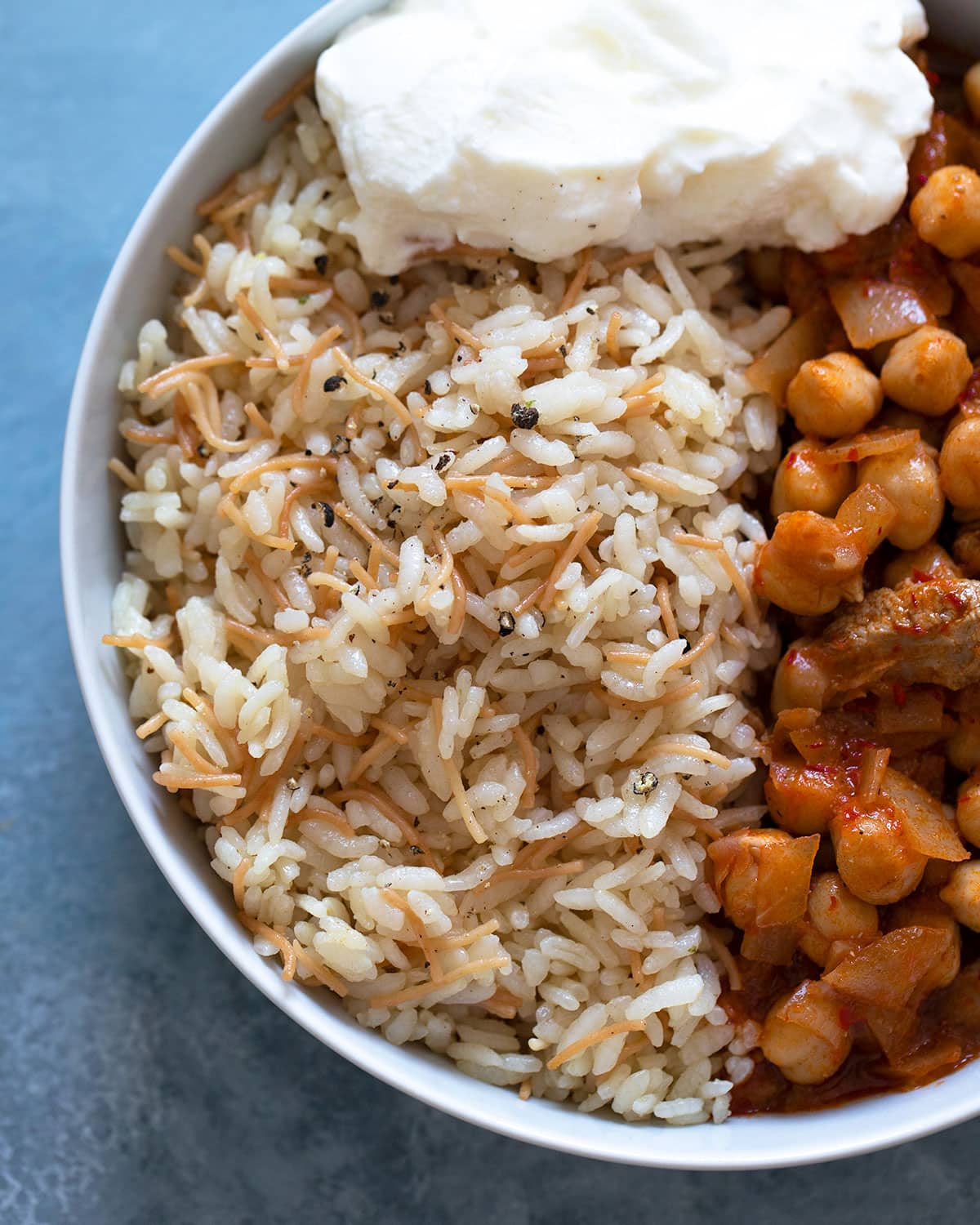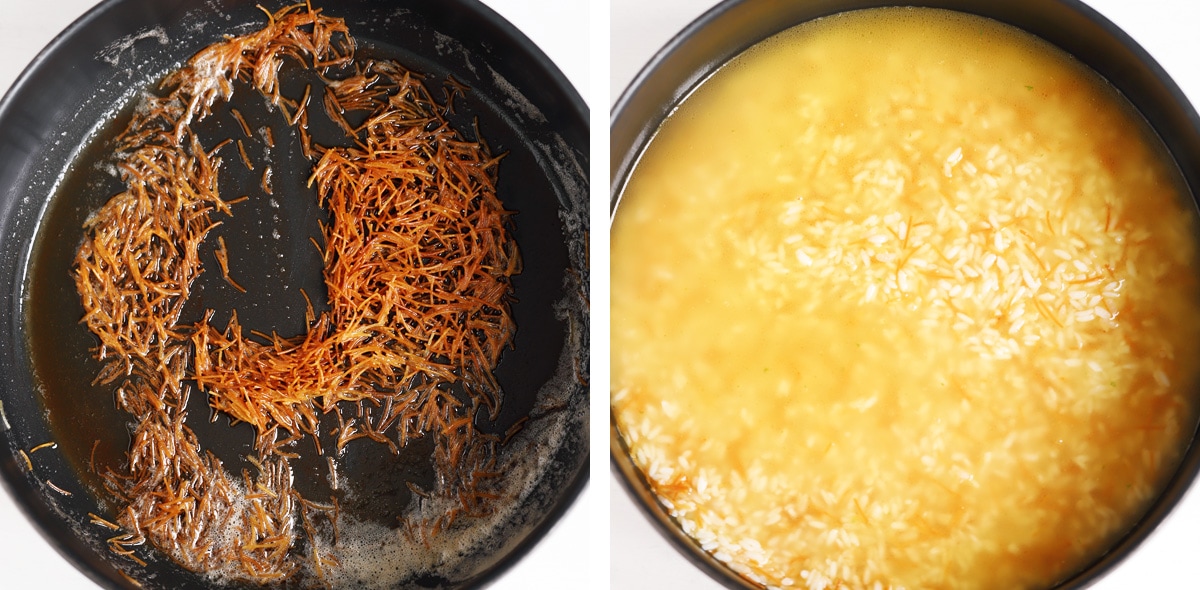I vote for Turkish rice pilaf with vermicelli (şehriyeli pirinç pilavı) to be elected as the most comforting rice ever. It’s buttery, plump and has a nice bite to it. It’s also extremely easy to make if you’ve got the right pan and the correct type of rice.
Rice has always been my favorite carb, but Turkish rice pilaf has been a revelation to me. It’s miles away from the boring plain boiled rice I grew up with (sorry, Dad, I love you). This recipe is from my Turkish in-laws and guarantees fluffy, savory rice in under one hour.
Foolproof method
I have a few Turkish cookbooks but whenever I tried their Turkish rice pilaf recipes it never turned up quite right. The rice was either not fully cooked, I was left with unabsorbed stock or worse of all, burnt rice was stuck to the bottom of the pan. These disappointing results were nowhere near the plump buttery fluffy rice I had many times over at my Turkish in-laws’ house. So it comes as no surprise that this is the first recipe I asked my in-laws to show me how to make when they first visited us in France!
I took lots and lots of notes, measuring up everything beforehand and observing which pan they used, on which burner etc… I was kind of expecting them to also fail since I did countless times. I was putting the blame on my pans, or the induction stove, but lo and behold on their first try, their Turkish rice pilaf was just as good as in Turkey, using my pans, and my stove!
The problem was with me, well my methods, all along. Cooking rice can be tricky and I was so thankful to be able to learn from people who just instinctively knew what to do in a different kitchen with different ingredients. And since then I’ve never made a bad batch of Turkish rice pilaf with vermicelli. When you’ve got a rice recipe that works for you, you stick with it!
Pan & rice
To make a traditional Turkish rice pilaf you should use a wide non-stick pan placed on the largest burner to make sure that the heat is evenly redistributed. The lid needs to be tight-fitting so as to not let precious steam escape. This will ensure that the grains are cooked throughout. This is what my pan looks like.
The choice of grain is also crucial and there’s nothing like baldo rice to make a true Turkish rice pilaf. Baldo rice is a type of medium-grain rice originating from the Piedmont region in Italy. It’s derived from the crossing of different grains, including Arborio rice. Baldo rice is cultivated in Balıkesir in Turkey and is commonly used for pilafs and to stuff vine leaves or vegetables. I buy baldo rice from a Turkish store, and it should have baldo pirinç written on the package. I can wholeheartedly recommend the brand Duru, since it’s what I always use. I recently spotted some at the supermarket in the world food section but I think it’s pretty rare.
If you can’t get to a Turkish store, I’ve had good results making this pilaf using Thai jasmine rice. It’s less chewy but you’ll still get a nice buttery Turkish rice pilaf.

Measuring with a mug
Turkish food culture is usually passed down orally and everything seems very approximate. There are no weight measurements, nothing is precise. Check a Turkish home cook’s notes, and you will see that ingredients are mainly ‘measured’ using different types of glasses. For instance, for a recipe you might need 3 “water” glasses of flour, 1 “tea” cup of milk, 1 “coffee” cup of sugar. No one has a scale but most of the çay teacups and Turkish coffee cups sold have a standardized size.
For a French person who grew up precisely weighing everything, this is madness. But every family recipe I followed using this method actually turned out alright. I’m not ditching my scale anytime soon but it definitely opened my mind to a more flowing way of cooking.
When my in-laws make their Turkish rice pilaf with vermicelli, they definitely don’t measure up any ingredients. They do everything using a tea mug and a tablespoon and so can you if you don’t want to use your scale! To do it the real Turkish way (but come on isn’t it nice to have some safe measurements you can rely on no I’m not a control freak): take a mug and fill it to the brim with rice, then follow the recipe. Use the exact same mug to measure up the stock. You will need 1 mug (filled to the brim again) + half of that quantity. So to sum up; 1 mug of rice + 1 ½ mug of chicken stock. Easy peasy.
Process


Wash the rice and let it soak.
Melt the butter over medium heat and add the pasta. Cook until they turn golden brown. Add the drained rice and cook for 2 min. Add the stock and salt, bring to a boil and cover the pan. Cook over medium-low heat for 10 min.
Fluff the cooked rice, cover it with a clean tea towel or pieces of paper towels and put the lid back on. Let it rest before serving.
Let it rest
Don’t skip the resting stage at the end for the best results. Leaving the rice to sit covered, off heat, will help the last drops of stock to evenly redistribute throughout the rice. It’s worth waiting 10 min for fluffy rice! Turkish rice pilaf with vermicelli isn’t supposed to be served steaming hot anyway. You’ll appreciate the flavors better if it’s just warm. You could let the rice rest for up to 30 min if you wish.
You can make Turkish rice pilaf as a side dish for chicken or fish, or as a meal on its own. Serving rice with yogurt on the side might seem weird but do try it! There’s nothing like the combination of buttery savory Turkish rice pilaf and creamy tangy yogurt.
Turkish rice pilaf with vermicelli
- Prep Time: 15 minutes
- soaking: 30 minutes
- Cook Time: 15 minutes
- Total Time: 1 hour
- Yield: 3 1x
- Category: Side dish
- Method: Stovetop
- Cuisine: Turkish
Description
A Turkish rice pilaf with vermicelli is buttery, savory and has a nice bite to it! It’s also extremely easy to make as long as you’ve got the right pan and the right kind of rice.
Ingredients
For the rice pilaf:
- 325g Turkish baldo rice (1 ⅔ cups), or use thai jasmine rice
- 2 tsp fine sea salt, divided
- 40g butter, diced (3 tbsp)
- 3 heaped tbsp tel şehriye pasta, or break angel hair into 2,5cm (1 inch) pieces
- 540ml chicken stock (2 ¼ cups), or use vegetable stock to keep it vegetarian
To serve:
- freshly ground black pepper
- spoonfuls of Turkish yogurt, or use full-fat Greek yogurt
Instructions
- Wash and soak the rice. Put the rice in a colander and rinse it under lukewarm running water until the water runs clear. Put the rice into a large bowl, cover it with lukewarm water, and mix in 1 tsp of salt. Let the rice soak for 30 min then drain using the colander again.
- Sauté the vermicelli. For this recipe you will need a wide non-stick pan that has a tight-fitting lid. The sides should be at least 8 cm (3 in) high. Place the pan on the largest burner and melt the butter over medium heat. Once melted, add the pasta and sauté stirring often with a wooden spoon until the şehriye turn golden brown. It usually takes around 3 to 4 min.
- Cook the rice. Add the rice to the pan, stir until most of the grains are coated in butter and cook for 2 min. Add the stock to the pan and the remaining 1 tsp of salt, stir and increase the heat to quickly bring to a boil. Cover with the lid and reduce the heat to medium-low. For example, the heats of my induction stove go from 1 to 10 (10 being the hottest) and I lower the temperature to 4 when I cook Turkish rice pilaf. Cook the rice, covered, for 10 min. If the stock hasn’t been completely absorbed by then, uncover the pan and keep cooking until it has. On the contrary, if the rice pilaf looks a bit dry and not completely cooked through (don’t hesitate to taste but be careful not to burn yourself) add a splash of water and keep cooking covered until absorbed.
- Let the Turkish rice pilaf rest. Turn off the heat, remove the lid and stir the rice gently with a wooden spoon. Lay a clean tea towel or several sheets of paper towels over the pan (it shouldn’t touch the rice). Put the lid back on and let the rice sit for 10 min. Fluff the rice gently again and serve sprinkled with freshly ground black pepper and big spoonfuls of yogurt!
Notes
Turkish rice pilaf can be made using arpa şehriye (orzo pasta) instead of tel şehriye (vermicelli/broken angel hair).
You can keep leftovers in an airtight container in the fridge for up to 3 days.
Nutrition
- Serving Size: 1
- Calories: 545
Keywords: baldo rice, stovetop rice
Looking for other Turkish side dishes? Here are some of my favorite recipes:

Océane
J’ai fait cette recette la semaine dernière et c’est vraiment délicieux. C’est tellement réconfortant avec le yaourt !
★★★★★